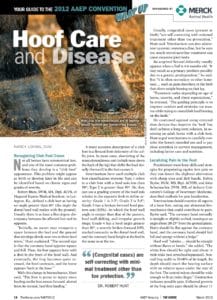
Biomechanics and Hoof Problems, Treatment (AAEP 2012)
One vet encouraged practitioners and farriers to take a biomechanical approach to treating some foot problems.


One vet encouraged practitioners and farriers to take a biomechanical approach to treating some foot problems.

Researchers evaluated if half-doses of Bute resulted in different plasma concentrations than full doses.

Learn about club feet, localizing pain, hoof biomechanics, and the role radiographs play in farriery.

The new Lyme disease test can reportedly detect antibodies as early as two to four weeks following infection.

Dr. Pat McCue gives a rundown on a number of 2012’s practical equine reproductive studies.

Veterinarians and farriers must work as a team to manage a horse’s athletic soundness and performance.

Laminitis is a devastating disease that does not discriminate based on a horse’s age, breed, or discipline.

One veterinarian reviews different non-steroidal joint medications commonly used in equine joint therapy.

In this particular study, the 5- and 60-second flexions did not yield the same results.

Researchers examined ways to minimize gastrointestinal complications when treating EP with imidocarb.

With appropriate care and use, vets can mitigate some risks associated with intra-articular corticosteroids.

Dr. Stephen Reed recaps studies on endocrinology, neurologic and muscle disorders, foal health, and more.

One veterinarian provides insight on BLM wild horse and burro project and the challenges it faces.
Keep a close watch on mares at risk for not carrying a foal to term.

Some nutritionists have speculated that certain dietary supplements might assist with equine ulcer management.

Veterinarians must take several steps to minimize the horse’s chances of developing a joint infection.
Stay on top of the most recent Horse Health news with